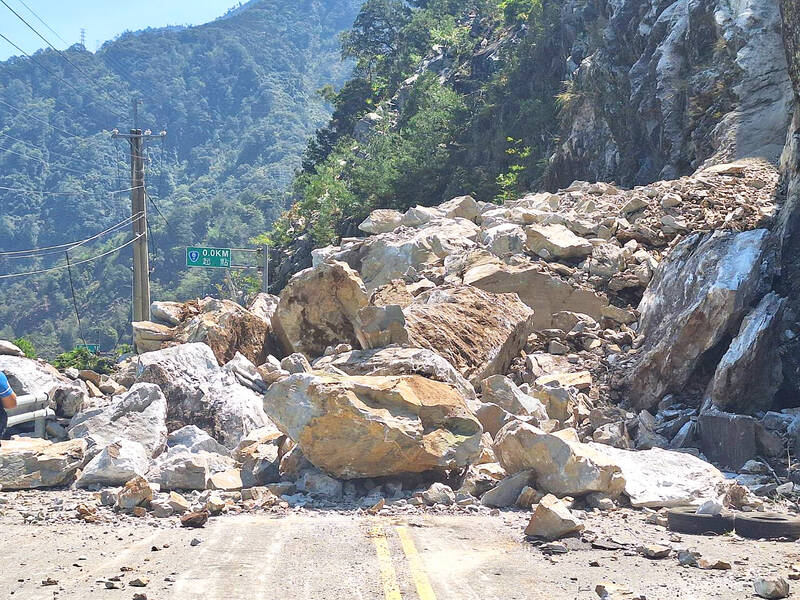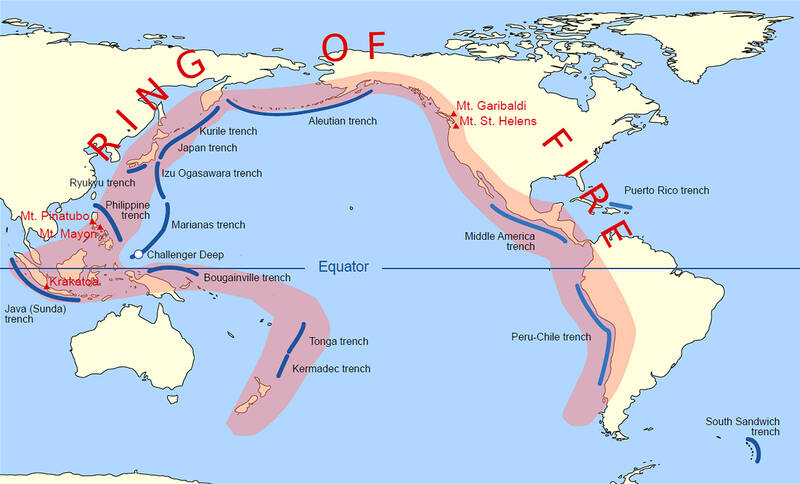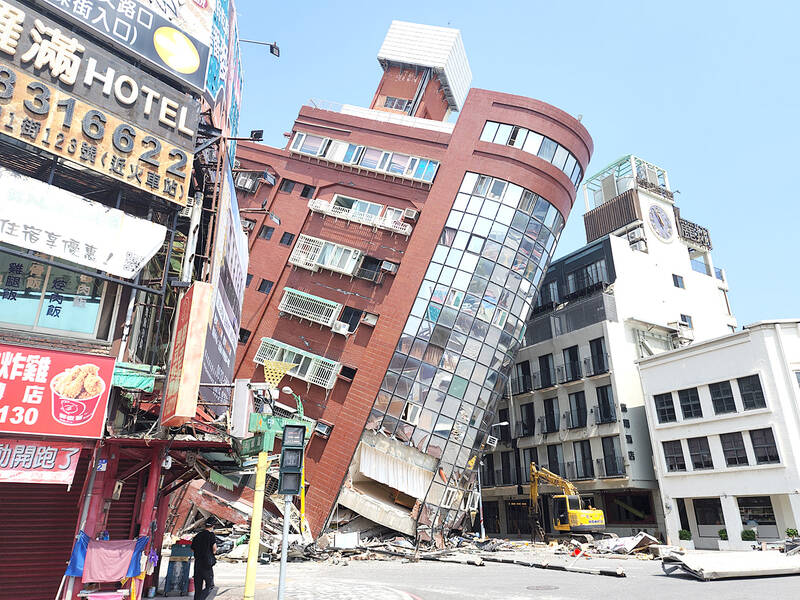The strongest earthquake to hit Taiwan in 25 years killed at least 16 people and damaged dozens of buildings, but the destruction was largely contained thanks to decades of preparedness work.
Taiwan sits on the “Ring of Fire,” an arc of intense seismic activity along the Pacific Rim, and — much like neighboring Japan — has a long history of catastrophic quakes.
How does April 3 compare with other recent quakes?

Photo courtesy of a member of public 照片:民眾提供
The April 3 earthquake, which measured 7.4 on the moment magnitude scale, was felt across Taiwan. It was the most severe since a 7.6 magnitude quake in 1999 killed 2,400 people, one of the deadliest natural disasters in the island’s history.
But the scale of destruction was far smaller than what happened last year in some other parts of the world.
On Feb. 6 last year, a 7.8 magnitude quake claimed more than 53,000 lives in Turkey and nearly 6,000 in Syria. Almost 39,000 buildings were destroyed.

Photo: Wikimedia Commons 照片:維基共享資源
Then in September, a 6.8 magnitude quake in Morocco killed 3,000 people and damaged around 60,000 homes.
Among the biggest factors, according to experts, are the building regulations and how firmly they are enforced. Collapsing structures are considered the main threat to life during an earthquake.
“There have been large earthquakes with very little damage because they caused little shaking and/or buildings were built to withstand that shaking,” according to the US Geological Survey.

Photo: Hua Meng-ching, Liberty Times 照片:自由時報記者花孟璟
“In other cases, smaller earthquakes have caused great shaking and/or buildings collapsed that were never designed or built to survive shaking.”
What has Taiwan done to guard its buildings against quakes?
Taiwan has included seismic requirements in its building codes for decades, enhancing and changing them as lessons were learned from major quakes on the island and elsewhere in the world.
Then came the 1999 quake, which destroyed more than 51,000 buildings and severely damaged around the same number, according to Taiwan’s National Center for Research on Earthquake Engineering (NCREE).
Since then, Taiwan has updated and enhanced its building code to incorporate quake-resistant construction methods, such as steel bars that allow a building to sway more easily when the ground moves.
Some major buildings that were designed before the 1999 quake were already incorporating features to guard against shaking.
The Taipei 101 skyscraper, which began construction a few months earlier and was once the tallest building in the world, has a 660-metric-ton damper that counteracts swaying.
According to the NCREE, around 80 buildings in Taiwan in 2009 had seismic features such as damping and that number grew to more than 1,000 by 2022.
What about older buildings?
The government also requires the reinforcement of structures built before the updated codes were introduced.
These older buildings are often the main cause for concern during earthquakes. There were complaints as recently as 2018 about a lack of funding for reinforcing such structures.
Further, the NCREE said in 2022 that buildings that do not have strong ground floors — such as those with public areas with open spaces — needed to be assessed and reinforced as soon as possible. These buildings are often called “soft-legged shrimps” in Chinese, according to the NCREE.
What has it done apart from building regulations?
Famous for its cutting-edge tech firms, Taiwan has built up an advanced early warning system that can alert the public to potentially serious ground shaking within seconds.
The system has been enhanced over the years to incorporate new tools such as smartphones and high-speed data connectivity, even in some of the most remote parts of the island.
Taiwanese authorities detect thousands of quakes every year — only a small fraction can be felt — and, much like Japan, disaster preparedness is a part of the culture, including regular drills at schools and workplaces.
What about Taiwan’s high-tech industry?
Taiwan is a semiconductor superpower and one of the world’s leading manufacturing hubs for the chips installed in everything from smartphones to SUVs.
It is home to companies including Foxconn, the world’s biggest contract electronics manufacturer, and the Taiwan Semiconductor Manufacturing Company (TSMC), which controls more than half the world’s chip output.
TSMC was among the companies that halted production after the earthquake to assess its facilities for any damage.
Semiconductor production, especially for high-end chips, requires immense levels of precision, which can prove challenging in a region prone to earthquakes.
Chip-making equipment is sensitive to the smallest vibrations, and firms such as TSMC have introduced various features into their buildings — such as dampers — to reduce the risk of damage to the semiconductors.
(AFP)
台灣25年來最強烈的地震,造成至少16人死亡,數十座建築受損,而數十年的防備工作,讓破壞程度大致上得到控制。
台灣地處「環太平洋地震帶」(∕環太平洋火山帶),這是環太平洋地區地震活動頻繁的弧形區域,台灣與鄰國日本一樣,災難性地震的歷史悠久。
4月3日地震與最近其他地震相比如何?
4月3日的地震達地震矩規模7.4級,台灣全境均有感。這是自1999年的7.6級地震以來最大的地震,當時造成兩千四百人死亡,是台灣歷史上死亡人數最多的自然災害之一。
但台灣這次的地震,其災損規模遠小於去年在其他國家發生的地震。
去年2月6日,一場7.8級地震在土耳其奪走了五萬三千多人的生命,以及敘利亞的近六千人。近三萬九千棟建築被摧毀。
之後在9月,摩洛哥發生了6.8級地震,造成三千人死亡,約六萬棟房屋受損。
專家表示,這差距的最大因素是建築法規及其執行力道。倒塌的建築被認為是地震時對生命的主要威脅。
美國地質調查局表示,「曾有過發生大地震,但造成很少損害的例子,這是因為地震所引發的震動很小,並且∕或者建築物建造時有耐震設計」。
「其他的情況則是,較小地震引發強烈的震動,以及∕或建築的設計或建造並未有耐震考量,因而倒塌」。
台灣採取何措施讓建築抗震?
台灣把抗震列入建築規範已有數十年,並由台灣及世界其他地方的重大地震汲取經驗,對這些規範加以強化及修改。
據台灣國家地震工程研究中心(簡稱國家地震中心,NCREE)表示,之後在1999年發生了921大地震,摧毀了五萬一千多棟建築,也有約同樣數目的建築嚴重損壞。
從那時起,台灣更新並強化了建築法規,納入抗震工法,例如在地面震動時能讓建築更容易搖晃的鋼筋。
1999年921地震前設計的一些主要建築,已加入了抗震功能。
921地震前數月開始建造的台北101摩天大樓,曾是世界上最高的建築,它有一個660噸重的阻尼器來抵消搖晃。
據國家地震中心表示,2009年台灣約有80棟建築具有阻尼器等抗震設施,2022年增加到一千多棟。
老舊建築該怎麼辦?
對於在新法規實施前所蓋的建築,政府也要求將其結構進行加固。
這些老舊建築往往是地震時最主要的安全疑慮。早在2018年,就有人抗議缺乏資金來加固這類建築結構。
此外,國家地震中心在2022年表示,那些沒有堅固底層的建築(例如有公共區域且其為開放空間之建築),需要盡快進行評估及加固。國家地震中心稱這些建築為「軟腳蝦」。
除了建築法規,還有哪些作為?
以尖端科技公司聞名的台灣,已建立先進的預警系統,可在幾秒鐘內向民眾發出警報,警告可能發生嚴重地震。
多年來,該系統已被強化,融入了智慧型手機和高速數據連接等新工具,甚至涵蓋台灣一些最偏遠的地區。
台灣當局每年都會偵測到數千次地震——只有一小部分是有感地震——而且,和日本一樣,防災是台灣文化的一部分,包括在學校及工作場所定期舉行演習。
台灣的高科技產業如何因應?
台灣是半導體超級大國,也是領先全球的晶片製造中心之一,從智慧型手機到運動型休旅車的各種產品中,都可見台灣製造的晶片。
全球最大的電子產品代工製造商富士康,以及控制全球一半以上晶片產量的台積電(TSMC)等公司,都位於台灣。
台積電是地震後暫停生產,以評估設備是否受損的公司之一。
製造半導體,尤其是高階晶片,需要極高的精密度,這在地震頻繁的地區可能會面對許多挑戰。
晶片製造設備對最小的振動都很敏感,台積電等公司已在其建築中引入各種設計(例如阻尼器),以降低半導體損壞的風險。
(台北時報林俐凱編譯)

A ‘Dutch angle’ is a classic camera technique that has been used in filmmaking since the 1920s, when it was introduced to Hollywood by German Expressionists. Why is it called the Dutch angle if it’s actually German? In fact, it has no __1__ to the Netherlands. The term “Dutch” is widely believed to be a misinterpretation of “Deutsch,” which means German in the German language. In any event, the name stuck, and the Dutch angle remains a popular cinematic tool to this day. This technique involves tilting the camera on its x-axis, skewing the shot to create a sense of

A: After “God of Songs” Jacky Cheung sang for late singer Khalil Fong recently, music streaming service KKBOX also paid tribute to Fong by releasing his greatest hits online. B: The 20th KKBOX Music Awards ceremony is taking place at the K-Arena in Kaohsiung tomorrow. Fong performed at the ceremonies in the past. A: Who are the performers this year? B: The performers include Taiwanese groups 911, Wolf(s), Ozone, Singaporean pop diva Tanya Chua, and K-pop group Super Junior. A: South Korean stars actually took four spots among KKBOX’s 2024 Top 10 singles, showing that K-pop is still

Historians are rethinking the way the Holocaust is being presented in museums as the world marks the 80th anniversary of the liberation of the last Nazi concentration camps this month. Shocking images of the mass killings of Jews were “used massively at the end of World War II to show the violence of the Nazis,” historian Tal Bruttmann, a specialist on the Holocaust, told AFP. But in doing so “we kind of lost sight of the fact that is not normal to show” such graphic scenes of mass murder, of people being humiliated and dehumanized, he said. Up to this

Dos & Don’ts — 想想看,這句話英語該怎麼說? 1. 能做的事都做了。 ˇ All that could be done has been done. χ All that could be done have been done. 註︰all 指事情或抽象概念時當作單數。例如: All is well that ends well. (結果好就是好。) All is over with him. (他已經沒希望了。) That’s all for today. (今天到此為止。) all 指人時應當作複數。例如: All of us are interested in his proposal. All of us are doing our best. 2. 我們這麼做有益於我們的健康。 ˇ What we are doing is good for our health. χ What we are doing are good for our health. 註︰以關係代名詞 what 引導的作為主詞的子句,動詞用單數。如: What he said is true. 3. 大家都沿著步道跑。 ˇ Everybody runs along the trail. χ Everybody run along the trail. 註︰everyone 是指一大群人,但在文法上一般用單數。 4. 桌上有一本筆記本和兩支筆。 ˇ There were two